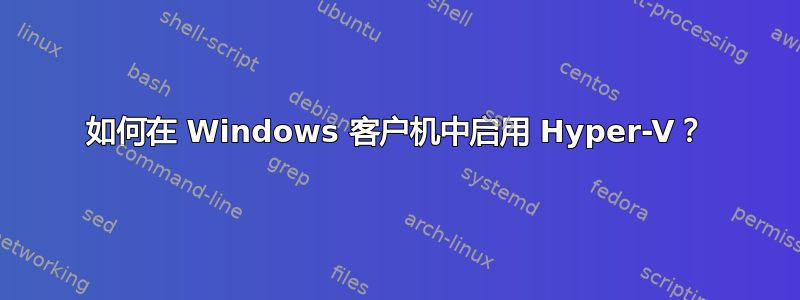
我在 QEMU kvm 下安装了 Windows 客户操作系统(主机是 Linux),系统运行正常,但是
任务管理器和都systeminfo显示 Hyper-V 受支持但在固件中被禁用,我该如何启用它?
如何使用 OVMF UEFI 设置或 QEMU 命令行参数来启用它,以便我可以拥有嵌套虚拟环境(如 Hyper-V 支持的内置沙箱)?
我已经kvm_intel nested=1按照说明进行了配置https://superuser.com/a/1100299/1060857并且我的主机报告支持嵌套虚拟化:
$ cat /sys/module/kvm_intel/parameters/nested
Y
$ virt-host-validate
QEMU: Checking for hardware virtualization : PASS
QEMU: Checking if device /dev/kvm exists : PASS
QEMU: Checking if device /dev/kvm is accessible : PASS
QEMU: Checking if device /dev/vhost-net exists : PASS
QEMU: Checking if device /dev/net/tun exists : PASS
QEMU: Checking for cgroup 'memory' controller support : PASS
QEMU: Checking for cgroup 'memory' controller mount-point : PASS
QEMU: Checking for cgroup 'cpu' controller support : PASS
QEMU: Checking for cgroup 'cpu' controller mount-point : PASS
... (all PASS)
如果我使用相同的 VM 来启动 Ubuntu Live CD,虚拟化似乎已经启用(在客户机中):
(guest)$ lscpu | grep -i Virtualiz
Virtualization: VT-x
(guest)$ lscpu | grep vmx | grep lm
Flags: fpu vme de pse tsc msr pae mce cx8 apic sep mtrr pge mca cmov pat pse36 clflush mmx fxsr sse sse2 ss ht syscall nx pdpe1gb rdtscp lm constant_tsc arch_perfmon rep_good nopl cpuid pni pclmulqdq vmx ssse3 fma cx16 pcid sse4_1 sse4_2 x2apic movbe popcnt aes xsave avx f16c rdrand lahf_lm abm 3dnowprefetch cpuid_fault invpcid_single pti tpr_shadow vnmi flexpriority ept vpid ept_ad fsgsbase tsc_adjust bmi1 hle avx2 smep bmi2 erms invpcid rtm mpx rdseed adx smap clflushopt xsaveopt xsavec xgetbv1 xsaves arat
(guest)$ cpu-checker
INFO: /dev/kvm exists
KVM acceleration can be used
相关配置
virsh xml:
<domain type='kvm' xmlns:qemu='http://libvirt.org/schemas/domain/qemu/1.0'>
<name>Windows-Server-2022</name>
<uuid>...</uuid>
<memory unit='KiB'>12582912</memory>
<currentMemory unit='KiB'>12582912</currentMemory>
<vcpu placement='static'>6</vcpu>
<os>
<type arch='x86_64' machine='pc-i440fx-xenial'>hvm</type>
<loader type='rom'>/usr/share/OVMF/OVMF_CODE.fd</loader>
<nvram template='/usr/share/OVMF/OVMF_VARS.fd'/>
<bootmenu enable='yes'/>
</os>
<features>
<acpi/>
<apic/>
<hyperv>
<relaxed state='on'/>
<vapic state='on'/>
<spinlocks state='on' retries='8191'/>
</hyperv>
<kvm>
<hidden state='on'/>
</kvm>
</features>
<cpu mode='host-passthrough'>
<topology sockets='1' cores='3' threads='2'/>
<feature policy='require' name='kvm'/>
<feature policy='require' name='vmx'/>
</cpu>
<clock offset='utc'>
<timer name='rtc' tickpolicy='catchup'/>
<timer name='pit' tickpolicy='delay'/>
<timer name='hpet' present='no'/>
</clock>
<on_poweroff>destroy</on_poweroff>
<on_reboot>restart</on_reboot>
<on_crash>restart</on_crash>
<pm>
<suspend-to-mem enabled='no'/>
<suspend-to-disk enabled='no'/>
</pm>
<devices>
<emulator>/usr/bin/kvm-spice</emulator>
<disk type='file' device='cdrom'>
<driver name='qemu' type='raw'/>
<source file='/home/ken/Downloads/SERVER_EVAL_x64FRE_zh-cn.iso'/>
<target dev='hdb' bus='ide'/>
<readonly/>
<address type='drive' controller='0' bus='0' target='0' unit='1'/>
</disk>
<disk type='file' device='cdrom'>
<driver name='qemu' type='raw'/>
<source file='/home/ken/Downloads/virtio-win-0.1.217.iso'/>
<target dev='hdc' bus='ide'/>
<readonly/>
<address type='drive' controller='0' bus='1' target='0' unit='0'/>
</disk>
<disk type='file' device='disk'>
<driver name='qemu' type='qcow2'/>
<source file='/media/vm0/windows-server/windows-server.qcow2'/>
<target dev='vda' bus='virtio'/>
<boot order='1'/>
<address type='pci' domain='0x0000' bus='0x00' slot='0x08' function='0x0'/>
</disk>
<controller type='usb' index='0' model='ich9-ehci1'>
<address type='pci' domain='0x0000' bus='0x00' slot='0x06' function='0x7'/>
</controller>
<controller type='usb' index='0' model='ich9-uhci1'>
<master startport='0'/>
<address type='pci' domain='0x0000' bus='0x00' slot='0x06' function='0x0' multifunction='on'/>
</controller>
<controller type='usb' index='0' model='ich9-uhci2'>
<master startport='2'/>
<address type='pci' domain='0x0000' bus='0x00' slot='0x06' function='0x1'/>
</controller>
<controller type='usb' index='0' model='ich9-uhci3'>
<master startport='4'/>
<address type='pci' domain='0x0000' bus='0x00' slot='0x06' function='0x2'/>
</controller>
<controller type='pci' index='0' model='pci-root'/>
<controller type='pci' index='1' model='pci-bridge'>
<model name='pci-bridge'/>
<target chassisNr='1'/>
<address type='pci' domain='0x0000' bus='0x00' slot='0x04' function='0x0'/>
</controller>
<controller type='pci' index='2' model='pci-bridge'>
<model name='pci-bridge'/>
<target chassisNr='2'/>
<address type='pci' domain='0x0000' bus='0x00' slot='0x07' function='0x0'/>
</controller>
<controller type='ide' index='0'>
<address type='pci' domain='0x0000' bus='0x00' slot='0x01' function='0x1'/>
</controller>
<controller type='virtio-serial' index='0'>
<address type='pci' domain='0x0000' bus='0x00' slot='0x05' function='0x0'/>
</controller>
<interface type='network'>
<mac address='52:54:00:9a:31:b7'/>
<source network='nat_win10'/>
<model type='virtio'/>
<address type='pci' domain='0x0000' bus='0x00' slot='0x03' function='0x0'/>
</interface>
<serial type='pty'>
<target port='0'/>
</serial>
<console type='pty'>
<target type='serial' port='0'/>
</console>
<channel type='spicevmc'>
<target type='virtio' name='com.redhat.spice.0'/>
<address type='virtio-serial' controller='0' bus='0' port='1'/>
</channel>
<input type='mouse' bus='ps2'/>
<input type='keyboard' bus='ps2'/>
<graphics type='spice' port='5910' autoport='no'>
<image compression='off'/>
</graphics>
<video>
<model type='qxl' ram='65536' vram='65536' vgamem='16384' heads='1'/>
<address type='pci' domain='0x0000' bus='0x00' slot='0x02' function='0x0'/>
</video>
<hostdev mode='subsystem' type='pci' managed='yes'>
<source>
<address domain='0x0000' bus='0x02' slot='0x00' function='0x0'/>
</source>
<address type='pci' domain='0x0000' bus='0x01' slot='0x01' function='0x0'/>
</hostdev>
<hostdev mode='subsystem' type='pci' managed='yes'>
<source>
<address domain='0x0000' bus='0x02' slot='0x00' function='0x1'/>
</source>
<address type='pci' domain='0x0000' bus='0x01' slot='0x02' function='0x0'/>
</hostdev>
<hostdev mode='subsystem' type='pci' managed='yes'>
<source>
<address domain='0x0000' bus='0x02' slot='0x00' function='0x2'/>
</source>
<address type='pci' domain='0x0000' bus='0x01' slot='0x03' function='0x0'/>
</hostdev>
<hostdev mode='subsystem' type='pci' managed='yes'>
<source>
<address domain='0x0000' bus='0x02' slot='0x00' function='0x3'/>
</source>
<address type='pci' domain='0x0000' bus='0x01' slot='0x04' function='0x0'/>
</hostdev>
<hostdev mode='subsystem' type='pci' managed='yes'>
<source>
<address domain='0x0000' bus='0x04' slot='0x00' function='0x0'/>
</source>
<address type='pci' domain='0x0000' bus='0x02' slot='0x01' function='0x0'/>
</hostdev>
<memballoon model='virtio'>
<address type='pci' domain='0x0000' bus='0x00' slot='0x0e' function='0x0'/>
</memballoon>
</devices>
<qemu:commandline>
<qemu:arg value='-cpu'/>
<qemu:arg value='host,hv_time,kvm=off,hv_vendor_id=1234567890ab,hv_vendor_id=null,-hypervisor,hypervisor=off'/>
</qemu:commandline>
</domain>
不是重复的:固件中已禁用 Hyper-V 虚拟化因为我的目标是在客户操作系统上而不是主机上启用 Hyper-V。
答案1
根据这篇文章 嵌套虚拟化 - qemu-kvm 中的 Hyper-V 2019,这必须在 VMX 配置文件中指定:
<features>
<acpi/>
<apic/>
<pae/>
<hyperv>
<synic state='on'/>
</hyperv>
</features>
<cpu mode='custom' match='exact' check='partial'>
<model fallback='allow'>Skylake-Server-noTSX-IBRS</model>
<feature policy='disable' name='hypervisor'/>
<feature policy='require' name='vmx'/>
</cpu>
<clock offset='utc' />
您将在文章中找到为什么需要合成中断控制器 (SynIC) 以及为什么 CPU 模型中不需要 TSX 的解释。
文章指出,在某些计算机上
<synic state='on'/>不需要标签,因此您可以尝试不用它。
答案2
不要忘记在 Windows 客户机上也打开 Hyper V 功能。我花了几个小时试图修复它。只需在 Windows 搜索栏中键入 windows 功能并启用以下选项即可:Hyper-V(及所有子项)Windows Hypervisor 平台


